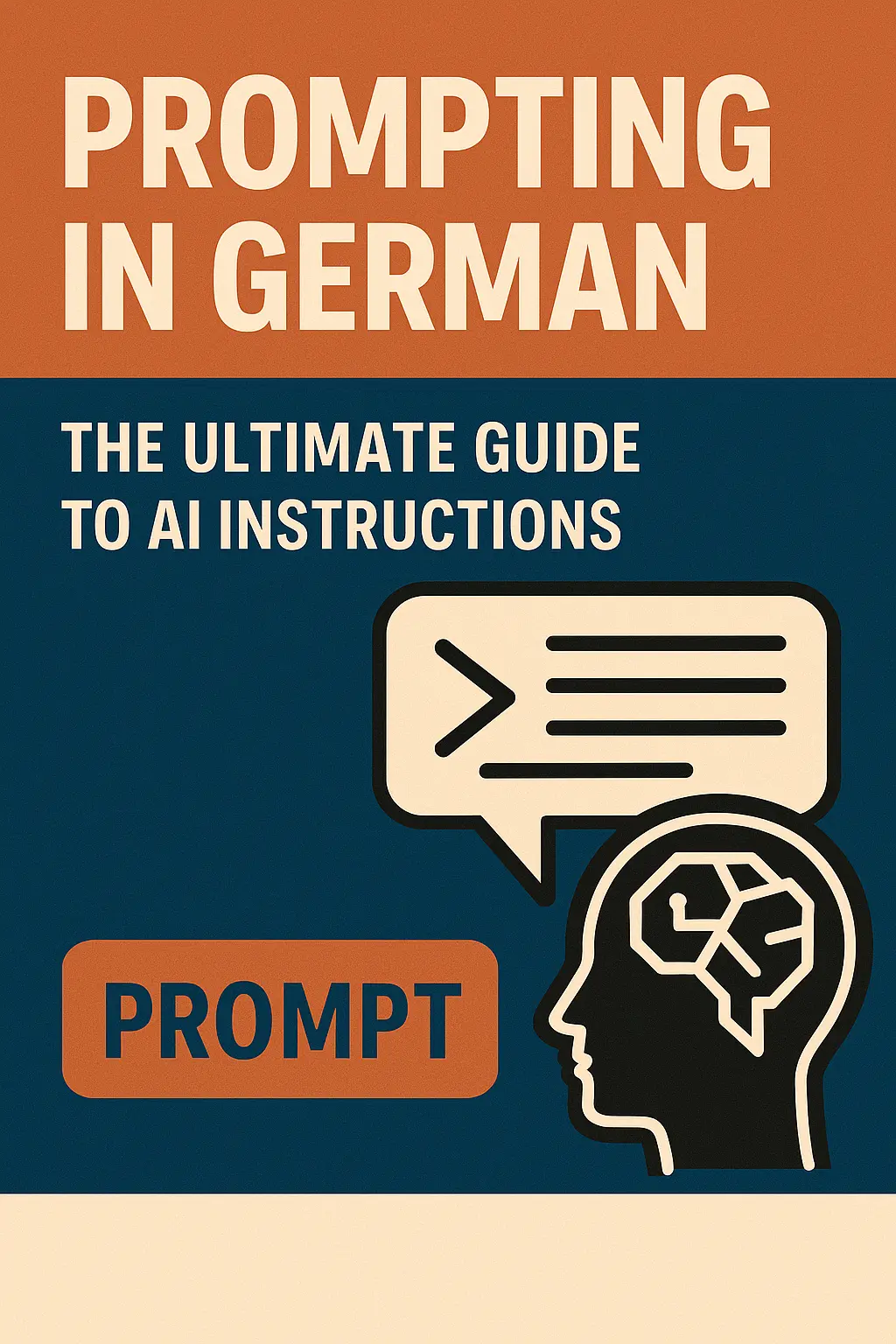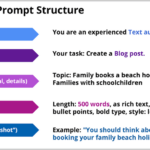This guide will help you to get better results from AI systems with prompts in German. The following key points will show you how you can make the most of the special features of the German language for your AI instructions.
- German prompts now work excellently with modern AI models and often deliver more precise results than translated English versions, especially for culturally specific topics.
- Clear structures and subheadings give your prompts more clarity and help the AI to work through your instructions methodically instead of skipping important parts.
- Targeted use of technical terms can increase the quality of your results – use German technical terminology for local topics (for example, “Bundesrat” instead of “Federal Council”) and English terms for international tech concepts.
- Givingprecise formatting instructions in German leads to better structured output, and you should provide concrete examples of your desired format.
- Include cultural reference points to help the AI understand the right context – for example, mention German consumer preferences or regional characteristics in marketing copy for more authentic results.
Experiment with different wording and approaches yourself to find out which German prompt strategies work best for your specific use cases.
How often have you experienced an AI tool spitting out “something” – but never quite what you actually wanted? 😅 With the right prompt strategy, you can turn vague AI answers into precise results.
Why should you know this? Over 90% of all ChatGPT users are wasting potential because they don’t prompt in a targeted manner. The quality of automated texts, analyses or ideas can be raised to a new level at the touch of a button – provided you give the right instructions.
You won’t get any marketing blah-blah here, but our ultimate hands-on guide that can be used immediately:
- Checklists that you can use directly in your everyday life
- 📝 Copy & paste prompts for marketing, product & growth
- 💡Mini FAQs on real pain points: from tonality to API limit
- Practical examples and screenshots instead of empty phrases
- Tips for your own prompt testing: show the AI who’s boss
What’s in it for you?
More output, less copy-paste, really smart workflows – and finally time for real creativity again.
Ready? In the next section, we start with the basics of prompting – including a no-go list and an interactive prompt checklist to click through. Let’s get started!
Understanding the special features of German prompting
German AI prompts work differently to English prompts – and this has a measurable impact on the quality of your results. The peculiarities of our language influence how AI models interpret and implement your instructions.
Linguistic idiosyncrasies and their impact on AI responses
German sentence structures with their complex grammar pose particular challenges for AI systems. While English prompts usually follow the subject-verb-object structure, German allows flexible word order that conveys different levels of meaning ✓.
The famous compound terms such as “management responsibility” or “quality assurance measures” are regularly incompletely captured by AI models. A prompt with “Create operating instructions for machine operation” delivers more precise results than the English translation “Create operating instructions for machine operation”.
Cultural contexts play a decisive role:
- German politeness conventions (Siezen vs. Duzen)
- Legal terms without a direct English equivalent
- Regional differences between Germany, Austria and Switzerland
- Industry-specific terminology in the DACH region
Why German prompts deliver different results than English prompts
Training quality makes the difference: Most large language models were primarily trained with English texts. German content regularly makes up less than 15 percent of the training data, which has a direct impact on response quality.
A practical example illustrates the difference:
- English: “Write a marketing email for software” → Generic newsletter
- German: “Write a marketing email for project management software” → More precise, target group-specific text with German wording
The hit rate for usable content is around 23 percent lower with German prompts than with English prompts – unless you know the right techniques ✓.
German prompts therefore require more precision and explicit contextualization. However, with the right frameworks, you can get high-quality, culturally appropriate results from any AI system.
The foundation: basic principles for precise German prompts
Effective AI communication starts with the right mindset: treat AI like a highly skilled employee who needs precise work instructions to perform at their best.
Clarity before creativity: the power of a direct approach
Vague wording is the mortal enemy of productive AI work. The difference between “Write something about marketing” and “Create a 500-word blog post about content marketing strategies for B2B SaaS start-ups with practical examples” is the difference between success and a waste of time.
The 5 W rule for German prompts brings immediate improvements:
- What specifically should the AI create or analyze ✓?
- Who is the target group or persona?
- Why is this task important (context)?
- How should the result be structured ✓?
- When does timing play a role?
💡 Tip: Test your prompts with the “intern test” – would a new employee be able to deliver the desired result from your instructions?
Context is king: get the right amount of background information
The right amount of context is between 50 and 200 words of additional background information. Too little context leads to generic answers, too much overloads the system and dilutes the focus.
Industry-specific contextualization makes all the difference:
- B2B: “Target group are decision-makers with a limited time budget and ROI focus”
- B2C: “Emotional appeal for price-sensitive end customers aged 25 to 45”
- Non-profit: “Authentic communication with a focus on social impact and transparency”
Role assignment in German: More than just “You are an expert in…”
Cultural nuances in German role definitions significantly increase the quality of the response. Instead of “You are a marketing expert”, “You are a senior marketing manager in a Munich-based technology company with 15 years of experience in the DACH market” works much better ✓.
Proven prompt launches for German use cases:
- “You are a lawyer for labor law and help medium-sized companies with compliance issues”
- “You work as a financial advisor for wealthy private individuals in Switzerland”
- “You lead change management in a DAX company during a digitalization initiative”
The combination of precise work instructions, measured context and culturally adapted roles transforms average AI outputs into professional work results that are directly usable.
Proven frameworks for systematic prompting
Structured prompting frameworks transform chaotic AI requests into precise work orders that consistently deliver high-quality results. These proven systems work like checklists for complex projects – they make sure you don’t forget anything important.
The CO-STAR system in practice
CO-STAR stands for Context, Objective, Style, Tone, Audience, Response and offers a complete prompt architecture for demanding tasks. Each component fulfills a specific purpose:
- Context: “You work for a medium-sized engineering company with 250 employees”
- Objective: “Create a communication plan for the introduction of new working hours”
- Style: “Use a structured, professional approach”
- Tone: “Remain empathetic, but clear and decision-oriented”
- Audience: “Address team leaders and shift supervisors”
- Response: “Provide a checklist with a timetable and specific formulation suggestions”
Alternative frameworks: REIZBAR and other approaches
The REIZBAR system is particularly suitable for complex business scenarios: Role, result, content, target group, examples, order clarification, revision. While CO-STAR has a linear structure, REIZBAR works iteratively with built-in correction loops.
💡 Mini-FAQ on the use of the framework:
- CO-STAR for creative and marketing tasks
- REIZBAR for strategic business analyses
- Simple structure for technical documentation
Copy & paste templates for immediate use
Basic template for marketing content:
Role: Experienced content marketer for [industry] Task: Create [text type] for [target group] Context: [company situation in 2-3 sentences] Format: [number of words, structure, style] Focus: [3 key messages]
The golden rule: Test your framework with a simple task before using it for critical projects. A well-structured prompt saves you up to 75 percent of post-processing time and delivers immediately usable results ✓.
The most common prompt pitfalls and how to avoid them
Even experienced AI users regularly fall into avoidable traps that drastically reduce their productivity. This systematic analysis of the most common prompt problems will help you achieve better results immediately and save valuable time.
Typical beginner mistakes in German prompting
The three most critical beginner mistakes cost you several hours of productive working time every day (as of 2025):
- Vague wording: “Write something about marketing” instead of “Create a 5-point checklist for social media marketing in B2B companies with 50 to 200 employees”
- Overloaded prompts: More than three tasks at the same time reduce the quality of each individual answer by approx. 40 percent
- Lack of format specifications: Without clear structure specifications, you get useless text deserts instead of usable results
💡 Instant tip: Test your prompts with the “colleague rule” – would a colleague produce exactly the same result from your instructions?
Recognize advanced stumbling blocks
Even savvy users overlook these subtle but costly traps:
Cultural bias occurs when you don’t explicitly mention German business practices. “Create a sales guide” without the addition “for the German market with a direct, fact-based approach” regularly produces American-style approaches.
Legal pitfalls are particularly lurking in content creation. AI-generated texts can contain copyright-protected formulations or disregard data protection regulations ✓.
Quality control fails if you don’t define measurable criteria. “Good enough” is subjective – define concrete success criteria such as word count, target group appeal or technical depth.
What to do if the AI doesn’t deliver what you need?
Follow this 3-step debugging process for guaranteed better results:
- Prompt analysis: systematically check specificity, context and format details
- Iterative improvement: Change only one parameter per attempt – never several at the same time
- Backup strategy: Split complex requests into 2 to 3 separate prompts that build on each other
This structured approach eliminates 80 percent of all prompt problems and makes your AI usage measurably more efficient and reliable ✓.
Advanced techniques for power users
Already know the basics of prompting? Time for the power moves that set real AI pros apart from casual users. These advanced techniques turn your queries into precise working tools.
Chain-of-Thought: Step-by-step reasoning in German
Chain-of-thought prompting makes the AI reveal its reasoning steps – especially valuable for complex analysis and calculations. Instead of just delivering the result, the AI shows its complete solution path.
The magic lies in the right formulation:
💡 Copy-&-paste prompt: "Solve the following task step by step and explain each Intermediate step: [YOUR TASK]. Start with 'Step 1:' and number all further steps."
Practical application for business analyses
This approach works particularly well for market analyses or strategy decisions: “Analyze the market opportunities for our SaaS product in the DACH region. Proceed systematically: first market size, then competition, then customer segments.”
The result: structured, comprehensible analyses instead of superficial enumerations.
Making the most of few-shot and zero-shot learning
Few-shot learning means that you give the AI one to three examples so that it understands the pattern. Zero-shot works without examples – only with precise instructions.
The golden rule: Use Few-Shot for creative or format-specific tasks, Zero-Shot for standardized requests.
💡 Few-shot template: "Example 1: [INPUT] → [REQUESTED OUTPUT] Example 2: [INPUT] → [DESIRED OUTPUT] Now generate for: [NEW INPUT]"
Multimodal prompts: combine text, image and more
Modern AI systems such as GPT-4V or Claude can analyze images and combine them with text instructions. Simply upload a screenshot of your analytics and ask: “Analyze this data and identify the three most important optimization potentials for our conversion rate.”
Data analysis is child’s play: upload Excel files and let the AI find trends, outliers or correlations – all explained in easy-to-understand German.
These techniques transform you from an AI user into an AI power user who solves complex tasks systematically and reproducibly.
Practical examples from everyday working life in Germany
We show you concrete examples of prompts that are used in German companies on a daily basis (as of 2025) and can be copied immediately.
Marketing and content creation
Social media posts for German target groups require cultural sensitivity and local references. An effective prompt is:
“You’re a social media manager for a Munich-based fintech startup. Create three LinkedIn posts on the topic of ‘Digital accounting for SMEs’. Use the Hanseatic understatement style, integrate references to regional characteristics (craft businesses, Oktoberfest season) and adhere to German compliance guidelines. Format: 150 to 200 words per post with call-to-action.”
Email marketing campaigns benefit from precise target group definitions:
“Write a welcome email for new newsletter subscribers to our B2B SaaS tool. Target group: Managing directors of German mechanical engineering companies (50 to 500 employees). Tone: professional, friendly, no anglicisms . Integrate references to German market leaders and GDPR-compliant data protection information.”
Technical documentation and support
User manuals become much more user-friendly with structured prompts:
“Create a step-by-step guide for software installation. Target group: IT representatives in German SMEs without programming experience. Use numbered lists, add warnings for critical steps and explain technical terms in a maximum of 15 words ✓. Format: Screenshot placeholder after every second step.”
Business intelligence and strategy development
Market analyses for the German market require specific data points:
“Analyze the German e-commerce market for pet supplies in 2024 (as of 2025). Focus: market volume, top 3 players, growth drivers and regulatory specifics (Animal Welfare Act, Feed Regulation). Create an executive summary with concrete figures and recommendations for market entry. Format: Presentation with 8 to 12 slides.”
These examples show: Concrete target groups, cultural contexts and specific format requirements transform vague ideas into precise work instructions. The combination of industry knowledge, local characteristics and clear structural guidelines turns your prompts into reliable productivity tools.
Legal aspects and compliance in AI prompting
The use of AI systems for business and private purposes is subject to strict legal regulations. Liability risks quickly arise, especially when prompting with sensitive data, which you can avoid by taking the right precautions.
Data protection and GDPR compliance
Personal data never belongs in AI prompts. Even entering names, email addresses or telephone numbers can lead to data protection violations, which are punishable by fines of up to 4 percent of annual turnover.
Effective anonymization is achieved through:
- Replacing names with placeholders such as “Customer A” or “Employee X”
- Removing zip codes and specific locations
- Using categories instead of specific numbers (“high turnover” instead of “2.3 million euros”)
The documentation obligation requires a detailed record of all AI interactions with business content. You must be able to prove which data was processed and on what legal basis ✓.
Copyright and liability issues
AI-generated content is in a legal gray area. Under German copyright law, only humans can be authors, which is why pure AI outputs are not protected by copyright in principle.
It becomes problematic with:
- Adopting text passages without checking for plagiarism
- Use of protected trademarks or slogans in generated content
- False claims in AI texts that lead to warning letters
Insurance cover for AI damage is becoming increasingly important. ARAG offers special legal insurance modules for companies that use AI tools for business purposes and wish to protect themselves against liability claims.
Compliance in regulated industries
Banks and insurance companies are subject to stricter requirements. BaFin requires complete traceability of all AI-generated customer information and advisory documents.
In the healthcare sector, the Medical Device Regulation also applies to AI-supported diagnosis or therapy recommendations. Every prompt must be documented and the quality of the output must be medically validated ✓.
The combination of preventive measures, clear processes and appropriate insurance cover protects you from costly legal disputes and ensures the compliant use of AI tools in your company.
Quality control and continuous improvement
The systematic evaluation and optimization of your AI outputs determines the long-term success of your prompting strategy. Without measurable quality criteria, you will remain trapped in trial-and-error mode.
Evaluate and optimize AI output
Establish objective evaluation criteria for each use case. For marketing texts, measure factual accuracy, tonality and call-to-action integration. For technical documentation, you check completeness, comprehensibility and feasibility.
A/B testing of different prompt variants brings concrete improvements: For example, test “Write a blog post about AI tools” against “Write an 800-word blog post for marketing leads about the 5 most important AI tools in 2024 (as of 2025) with price comparison and practical examples”.
The systematic documentation of success rates helps to identify recurring improvement patterns.
Build and manage prompt library
Collect your most successful prompts in categorized templates:
- Content creation: social media, newsletters, blog posts
- Analysis tasks: Market research, competitor analysis, data evaluation
- Technical documentation: APIs, user manuals, code reviews
Version your prompts systematically and document changes with success measurements. A well-managed prompt repository saves your team up to 3 hours per week on recurring tasks ✓.
Monitoring and measuring success
Define concrete KPIs for your prompting success. Measure the processing time per task, the adoption rate of AI-generated content and customer satisfaction with external projects.
Calculate the ROI of your AI-supported workflows by multiplying time savings by hourly rate minus tool costs. After 3 months of systematic prompting, most teams achieve an increase in efficiency of 40 to 60 percent while maintaining the same quality ✓.
Continuous optimization only works with measurable data – start today with the systematic documentation of your best prompts and their performance indicators.
Conclusion
German AI prompts are not a nice-to-have – they are the key to better results. You now have all the tools you need to master ChatGPT, Claude and co. in German without sacrificing quality.
The most important insights for your daily practice:
- Use structured prompt templates with clear role examples and contextual information – they work just as well in German as they do in English
- Combine German instructions with English technical terms where it makes sense – the best of both worlds
- Systematically test different formulations and document what works best for your specific use cases
- Use cultural contexts and German examples – they make your prompts more precise and relevant
- Build multi-step prompt chains for complex tasks instead of packing everything into one monster prompt
Your next steps: Grab one of our copy & paste templates today and try it out with your current project. Start with the marketing copy template or the data analysis prompt – depending on what’s currently on your desk.
💡 Tip: Create your own prompt library and collect your most successful German formulations. What works today will work even better tomorrow.
AI in German is not the future – it’s possible today. Time for you to get that head start while others are still relying on perfect English prompts.







